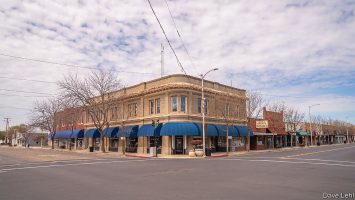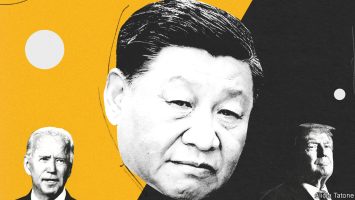
Your browser does not support the <audio> element.
In politics, the highest drama is often about nothing. So it is in the Windy City at least. For the past few weeks, Chicago’s city council has been tearing itself apart over a proposal to hold a referendum on whether or not to repeal the executive order from 1985 which declared the place a “sanctuary city” for illegal immigrants. Some 20,000 or so migrants bused from Texas over the past year have stretched the city’s finances and capacities. The fight shows the strain the migrant crisis is putting on the coalition that propelled the mayor, Brandon Johnson, a progressive teachers’-union organiser, to a narrow election victory in April. It also hints at a difficulty more broadly for Democrats: migration is not necessarily as popular with their voters as with the party elite.
The drama began in earnest on November 2nd, when a special council meeting was called to consider the proposal for a referendum, drafted by a right-leaning alderman (as Chicago calls city-council members). That meeting was cancelled when too few turned up to reach a quorum. It soon became clear why: Carlos Ramirez-Rosa, the floor leader and an ally of Mr Johnson, had used his political and personal clout to stop members from appearing. Mr Ramirez-Rosa was accused of physically blocking Emma Mitts, a long-standing member of the black caucus, from going inside. Later he was accused of threatening to hold up zoning hearings in several members’ seats to persuade them not to attend. (He denies that, but says he “can see why” aldermen thought so.)
On November 6th he resigned his floor-leader position, and on November 7th escaped censure for his conduct by the mayor’s tie-breaker vote. That came at the end of a day which began with anti-migrant protesters being thrown out of the public gallery. Security claimed the move was to stop disruption. Others present suggested it was in fact to avoid scenes of people protesting against migrants. A vote was also cancelled on a softer, mayorally-preferred alternative referendum question, which would ask whether to “impose reasonable limits on the city’s providing resources for migrant sheltering…if necessary to prevent a substantial negative impact on Chicago’s current residents”.
Dollars and sense
The irony of the debate is that Chicago’s sanctuary-city status has little to do with its migrant difficulties. A “sanctuary city” is one in which the police and other officials do not co-operate with federal immigration officers to deport undocumented migrants. The people coming from Texas are for the most part Venezuelan asylum-seekers with protection from deportation. The only way in which removing “sanctuary city” status might change the situation is if it were to persuade Greg Abbott, the governor of Texas, to put fewer of them on buses, which seems unlikely.
The actual migrant problem Chicago faces is where to house them, and how to pay for it. At the end of October 3,344 people were living at “staging areas”: mostly the lobbies of police stations, as well as on the floor at O’Hare international airport. But as the city’s brutal winter approaches, that will prove unsustainable. In September Mr Johnson struck a $29m contract with a firm, GardaWorld, to provide a “winterised base camp”, where newly arrived migrants will be housed in heated barracks-like tents. Yet he has struggled to get aldermen to agree to a site. Only on November 7th, a week after the first snow of the year, was a derelict supermarket on the South Side finally purchased.
The strains partly reflect Chicago’s curious city structure, where the council tends to rubber-stamp mayoral decisions, while in exchange members act like little kings in their own wards. But the bigger problem is the money. In September the city projected a $538m deficit next year. Housing migrants is expected to cost $300m next year. Some black voters worry that their needs are being overlooked. A poll conducted in early October (albeit by a Republican pollster) apparently found that while white voters largely back retaining Chicago’s “sanctuary city” status, minority voters reject it.
To quote one public commenter before the November 7th meeting, “illegal immigrants are coming in…to displace the native blacks”. If anyone needs sanctuary, he went on, “it’s black people.” In September Willie Wilson, a black businessman who won 9% of the first-round vote in Chicago’s mayoral election in February (and a larger share of black votes), wrote in the Chicago Tribune that city taxpayers are being “fleeced” by a “manufactured” migration crisis. “President Biden and the Democrats’ weak immigration policies are to blame,” he argued. He called for the mayor and J.B. Pritzker, Illinois’s Democratic governor, to take in migrants personally.
For Mr Johnson this is tricky territory. His initial support in February came from the most left-leaning white Chicagoans; he won over most black voters only in the second round. He says that the distribution of money is “not a zero-sum game”, and promises to “provide for every single Chicagoan”. But Democrats generally are nervous. A New York Times poll published on November 6th suggested over a fifth of black voters in six close-fought states would vote for Donald Trump (who won just 8% of black votes nationally in 2020). In 2020 Joe Biden came to the presidency largely thanks to black voters. Republicans will be hoping they have finally found a wedge issue that works. ■
Stay on top of American politics with Checks and Balance, our weekly subscriber-only newsletter, which examines the state of American democracy and the issues that matter to voters.



